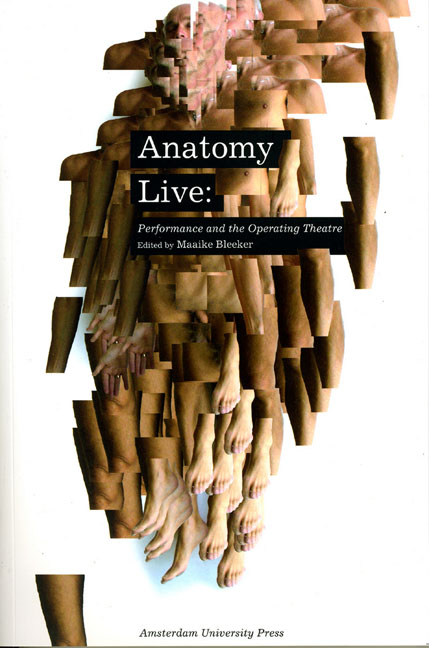Book contents
- Frontmatter
- Contents
- Acknowledgements
- Prologue - Men with Glass Bodies
- Introduction
- Performance Documentation 1: Holoman; Digital Cadaver
- Digital Cadavers and Virtual Dissection
- ‘Who Were You?’: The Visible and the Visceral
- Performance Documentation 2: Excavations: Fresh but Rotten
- The Anatomy Lesson of Professor Moxham
- ‘Be not Faithless But Believing’: Illusion and Doubt in the Anatomy Theatre
- Performance Documentation 3: De Anatomische Les
- Of Dissection and Technologies of Culture in Actor Training Programs – an Example from 1960s West Germany
- Ocular Anatomy, Chiasm, and Theatre Architecture as a Material Phenomenology in Early Modern Europe
- Performance Documentation 4: Camillo – Memo 4.0: The Cabinet of Memories – A Tear Donnor Session
- Martin, Massumi, and the Matrix
- Performance Documentation 5: Sensing Presence no 1: Performing a Hyperlink System
- ‘Where Are You Now?’: Locating the Body in Contemporary Performance
- Performance Documentation 6: Under My Skin
- Anatomies of Live Art
- Performance Documentation 7: Crash
- Restaging the Monstrous
- Delirium of the Flesh: ‘All the Dead Voices’ in the Space of the Now
- Performance Documentation 8: Körper
- Operating Theatres: Body-bits and a Post-apartheid Aesthetics
- Index
Performance Documentation 5: Sensing Presence no 1: Performing a Hyperlink System
Published online by Cambridge University Press: 10 February 2021
- Frontmatter
- Contents
- Acknowledgements
- Prologue - Men with Glass Bodies
- Introduction
- Performance Documentation 1: Holoman; Digital Cadaver
- Digital Cadavers and Virtual Dissection
- ‘Who Were You?’: The Visible and the Visceral
- Performance Documentation 2: Excavations: Fresh but Rotten
- The Anatomy Lesson of Professor Moxham
- ‘Be not Faithless But Believing’: Illusion and Doubt in the Anatomy Theatre
- Performance Documentation 3: De Anatomische Les
- Of Dissection and Technologies of Culture in Actor Training Programs – an Example from 1960s West Germany
- Ocular Anatomy, Chiasm, and Theatre Architecture as a Material Phenomenology in Early Modern Europe
- Performance Documentation 4: Camillo – Memo 4.0: The Cabinet of Memories – A Tear Donnor Session
- Martin, Massumi, and the Matrix
- Performance Documentation 5: Sensing Presence no 1: Performing a Hyperlink System
- ‘Where Are You Now?’: Locating the Body in Contemporary Performance
- Performance Documentation 6: Under My Skin
- Anatomies of Live Art
- Performance Documentation 7: Crash
- Restaging the Monstrous
- Delirium of the Flesh: ‘All the Dead Voices’ in the Space of the Now
- Performance Documentation 8: Körper
- Operating Theatres: Body-bits and a Post-apartheid Aesthetics
- Index
Summary
Isabelle Jenniches, Stefan Kunzmann and Renée Copraij presented a short performance in spring 2001, in the historical anatomical theatre in De Waag in Amsterdam. This was once the ‘hometheatre’ of anatomist Nicolaes Tulp, ‘surgeon and representative of the civil authority, anatomist and frequent office holder in the bourgeois government,’ to quote Francis Barker (1995, p. 103). Tulp is the man depicted by Rembrandt in his famous The Anatomy Lesson of Dr Nicolaes Tulp, which shows Tulp's magisterial dissection of the executed criminal Aris Kindt :
at which Descartes was probably present; anatomist himself, philosopher and legislator of modern subjectivity, who, mediating by the stove, considering strangely whether his body exists, uses the wax that is to hand to prove that corporeal objects have no consistency or essentiality but extension in space. (Barker, 1995, p. 103)
Jenniches, Kunzmann and Copraij chose this theatre for a performance in which they engage with the Cartesian mind-body opposition, and the identification of mind with that which does the thinking.
One day prior to the performance, the audience received an e-mail with an invitation to visit the project website, http://www.9nerds.com/sk/waag/. Here, the audience encountered: a) a figure consisting of several lines and several small circles ‘dancing’ rhythmically up and down; and b) a discontinuous line, moving in the same rhythm. The visitor was given no clue as to the purpose or intention of this figure. The only way to try to understand it was to engage with it, and to engage with it meant to move through it. After clicking on the image, the visitor was able to move the discontinuous line through the figure. When this line hit one of the small circles, the appearance of a little hand sign invited the visitor to click again. As a result, a connection between two little circles was made, and the line in the diagram connecting these two little circles would become slightly thicker. After clicking, several of the circles would disappear and/or others appear, allowing for new connections to be made.
- Type
- Chapter
- Information
- Anatomy LivePerformance and the Operating Theatre, pp. 165 - 168Publisher: Amsterdam University PressPrint publication year: 2008



